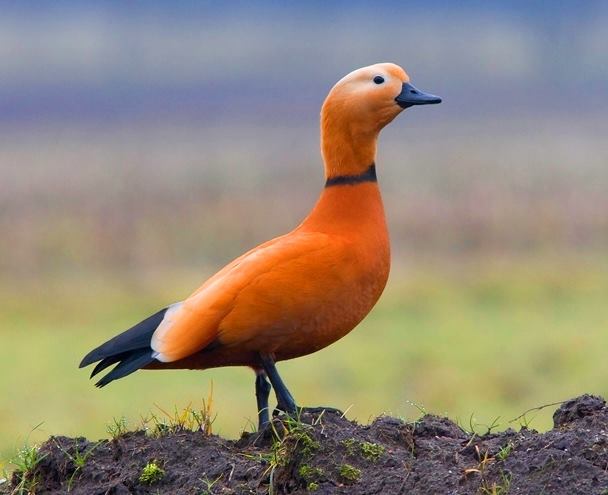
Ruddy Shelduck (Tadorna ferruginea)
Species name
- Dutch name:
- Rode casarca
- English name:
- Ruddy Shelduck
- German name:
- Rostgans
- French name:
- Tadorne casarca
- Scientific name:
- Tadorna ferruginea
Scientific classification
- Order:
- Anseriformes
- Family:
- Anatidae
- Onderfamilie:
- Tadorninae
- Genus:
- Tadorna
Description
- Description:
Male:
Yellowish head and neck, with darker nape. During the breeding season, we can see a blackish collar, but it is sometimes concealed and invisible.has rusty orange plumage overall, except black rump, undertail-coverts and tail. On the wings, the coverts are whitish, washed yellowish-orange in fresh plumage. Primary and secondary flight feathers are black, with green mirror on secondaries. On the underwing, the flight feathers are black, contrasting with the white coverts. Bill is black. The eyes are dark brown. Legs and feet are black.Female:
Has similar plumage but she lacks the collar. She has whitish face and paler head and neck. The bill is black. The eyes are dark brown. Legs and feet are black.Juvenile:
Is duller than female, with washed grayish-brown plumage especially on head and upperparts.
Standard Measurements
- Body Length (cm):
- The male (drake) of the Ruddy Shelduck measures approximately 58-71 centimeters. The female measures approximately 58-71 centimeters.
- Body Weight (grams):
- The male will weight about 920-1630 gram. The female will weight about 920-1630 gram.
The weight is notoriously variable and can only be used as indication!
- Note:
Shelducks are generally winter hardy. Their pen should contain short grass for grazing, and they appreciate a degree of cover. Minimum enclosure size suggested for a pair of shelduck is 100 square metres.
They tend to be aggressive particularly in the breeding season, and may even kill small ducks, and a separate enclosure is usually required. There is some species-based and individual variation in degree of aggression.
Most species prefer to use a partially-buried nest box with a tunnel entrance, usually in the form of a drain pipe. A suggested nest box size is 30x30x40cm, with a 15cm diameter entrance tunnel drain pipe, or 15x15cm square entrance tunnel, minimum 30cm long. Ground-level nest boxes with a 15cm diameter entrance hole may also be used.
Ruddy shelducks are winter-hardy. Their management is not difficult, but a separate enclosure is suggested for the breeding season, as they are aggressive, particularly while rearing ducklings; several pairs may be kept as a group on very large areas. Cover in the pen is appreciated. Feed floating pellets, greenfood, grass: plenty of green food to supplement grass.
These shelducks are commonly bred in captivity. Burrow-type nest boxes with a drainpipe entrance should be provided. They may also raised nest box or hollow log, kennel, wigwam or possibly a surface-level box. Eggs are usually laid from mid-March to May. These shelducks are usually reliable incubators and excellent parents, with both parents defending ducklings from predators. The ducklings are not difficult to rear; plenty of green food (e.g. duckweed, lettuce) should be provided as well as starter crumbs, with access to grazing from an early age. Broody hens have been used, and Egyptian goose (Alopochen aegyptiacus) used as a foster.
Hybridisation may occur with other Tadorna species, and has been reported with Egyptian goose (Alopochen aegyptiacus), Barnacle goose (Branta leucopsis) and other goose species, and large Anas spp.
- Breeding:
- The female Ruddy Shelduck usually lays from 8-12 eggs and incubates them for 28-29 days.
- Artificial incubating:
The ideal relative humidity for incubating most waterfowl eggs is 55% (ground nesters) and 40% (cavity nesters). The temperature is usually 37.4°C. Set ventilation as recommended by the incubator manufacturer. Eggs must be turned, either automatically or by hand, a minimum of 4 times a day. As the duckling develops there is a loss of water from the egg and the air sac gets bigger. In normal development of an egg with a 28-29 days incubation, the air sac occupies about a third of it three days earlier. Cleanliness is vital and ideally eggs should be moved to a separate hatcher at this point, where the humidity should be increased to 65% and even higher once they have pipped internally.
- Bird banding:
- Recommended closed leg band ring size for the Ruddy Shelduck is 13 mm.The leg band ring can only be applied on a young shelduck at around 14 days old.
- It doesn't matter what leg that you band, but it's good to have a consistent system. Suggested: Left leg = Female, Right leg = Male
- Rearingfeed:
-
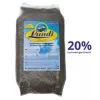
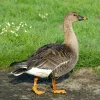

Floatable special rearing feed for all types of aquatic ornamental fowl - especially for the cultivation of trees as well as greening ducks.
This well-balanced complete feed with 20% protein content convinces above all by its good compatibility and forms the basis for visibly healthy growth from day one.
Made exclusively from wholesome and selected raw materials, Lundi Micro Regular is also ideally suited for the year-round feeding of waterfowl.
- Maintenance food:
-



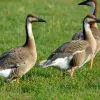

Lundi Regular with a protein content of 20%, valuable Spirulina and high-quality by-products is optimally balanced in its composition maintenance food for water ornamental fowl of all kinds. Especially green teal and Whistling ducks that are not dependent on a very high protein content, are well supplied.
Lundi Regular contains all the minerals and vitamins in full form that are important for the animals. Therefore also suitable as breeding food.


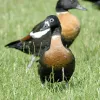


Floating full food for all sea ducks, green ducks, eider ducks and geese, especially in the moulting and breeding phase ideally suited. Packed with wholesome raw materials, natural vitamins and trace elements, this performance food with a protein content of 30% forms the basis for lifelong vitality.
- Regulation:
- Europese soort
- Regulation:
Het is niet verboden om deze vogels te houden die van nature in Nederland voorkomen, op voorwaarde dat deze vogels in gevangenschap zijn geboren; nakweek dus. Deze vogels zijn voorzien van een gesloten pootring. Het is wel verboden om deze vogels te houden die in het wild gevangen zijn. Alleen bepaalde instanties, zoals vogelasiels en vogelhospitalen, zijn bevoegd om jonge en gewonde wilde vogels te houden. Deze bescherming van vogels wordt vormgegeven door schadelijke handelingen te verbieden zoals:het doden, verwonden, vangen, bemachtigen en met het oog daarop opsporen van vogels (art. 9 Flora- en faunawet); het opzettelijk verontrusten van vogels (art. 10 Flora- en faunawet);het beschadigen, vernielen, uithalen, wegnemen en verstoren van nesten, holen of andere voortplantings- of vaste rust- of verblijfplaatsen van vogels (art. 11 Flora- en faunawet);en het zoeken, rapen, uit het nest nemen, beschadigen of vernielen van eieren van vogels (art. 12 Flora- en faunawet).

